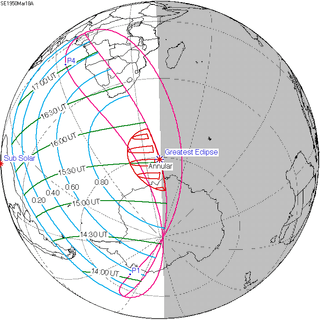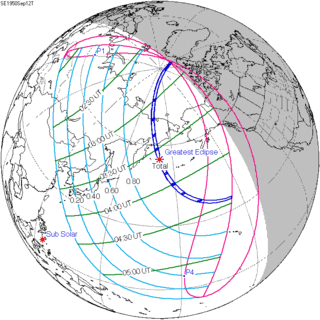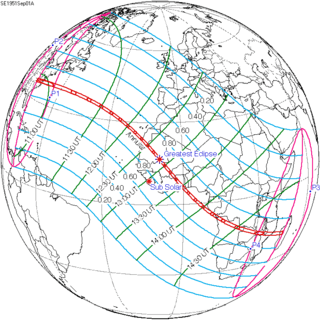Solar eclipse of February 14, 1953
A partial solar eclipse occurred on February 14, 1953. A solar eclipse occurs when the Moon passes between Earth and the Sun, thereby totally or partly obscuring the image of the Sun for a viewer on Earth. A partial solar eclipse occurs in the polar regions of the Earth when the center of the Moon's shadow misses the Earth.
| Solar eclipse of February 14, 1953 | |
|---|---|
 Map | |
| Type of eclipse | |
| Nature | Partial |
| Gamma | 1.1331 |
| Magnitude | 0.7596 |
| Maximum eclipse | |
| Coordinates | 61.9°N 104.9°E |
| Times (UTC) | |
| Greatest eclipse | 0:59:30 |
| References | |
| Saros | 149 (17 of 71) |
| Catalog # (SE5000) | 9404 |
Related eclipses
Solar eclipses of 1950–1953
This eclipse is a member of a semester series. An eclipse in a semester series of solar eclipses repeats approximately every 177 days and 4 hours (a semester) at alternating nodes of the Moon's orbit.[1]
| Solar eclipse series sets from 1950–1953 | ||||||
|---|---|---|---|---|---|---|
| Ascending node | Descending node | |||||
| Saros | Map | Saros | Map | |||
| 119 |  March 18, 1950 Annular (non-central) |
124 |  September 12, 1950 Total | |||
| 129 |  March 7, 1951 Annular |
134 |  September 1, 1951 Annular | |||
| 139 |  February 25, 1952 Total |
144 |  August 20, 1952 Annular | |||
| 149 |  February 14, 1953 Partial |
154 |  August 9, 1953 Partial | |||
| Solar eclipse of July 11, 1953 belongs to the next lunar year set | ||||||
gollark: Someone would probably stop you patenting-or-whatever existing natural things, but I'm sure you can patent your own stuff.
gollark: Probably!
gollark: BRB, patenting colds.
gollark: All Nvidia drivers are buggy.
gollark: Ah, termux. You are a man of taste, Bob.
References
- van Gent, R.H. "Solar- and Lunar-Eclipse Predictions from Antiquity to the Present". A Catalogue of Eclipse Cycles. Utrecht University. Retrieved 6 October 2018.
This article is issued from Wikipedia. The text is licensed under Creative Commons - Attribution - Sharealike. Additional terms may apply for the media files.
.jpg)
